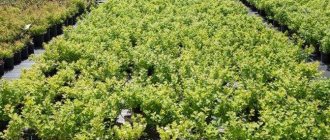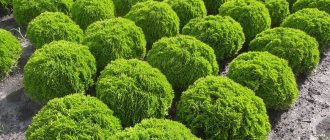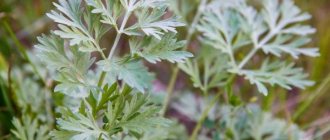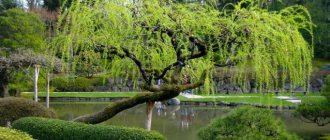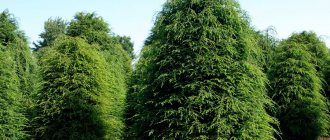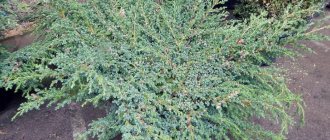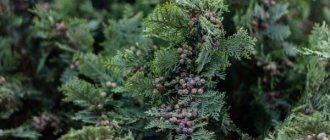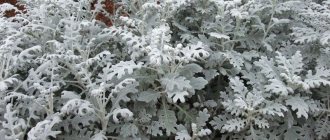The universal culture Lawson cypress in the hands of a gardener is an excellent tool for solving any original problems in landscape design. The flexible plant lends itself easily to formative pruning, is recommended for arranging hedges, and looks good in a single planting and in picturesque flower beds.
Description of Lawson's cypress
In nature, this plant grows mainly in Oregon and California. Here you can find 500-year-old specimens of Chamaecýparis lawsoniána, up to 80 m high with a trunk diameter of up to 5 m. It belongs to the Cupressáceae family and is an evergreen coniferous tree. Let's take a closer look at the description of the Lawson cypress plant:
- The crown is columnar or conical.
- The branches are slightly drooping or vertical.
- The shoots are highly branched and elongated.
- The needles are dense with a scaly structure.
- The size of flat leaves is 1.5-2 mm.
- The lateral leaves are compressed and twice as long.
- The color of male anthers is purple.
- Female cones are violet-gray in color.
- Mature buds turn bluish-brown or purple-orange.
- The shape of the cones is ovoid-spherical.
- The size of the cones is up to 1.2 cm.
Lawson's cypress - characteristics
Errors with the choice of variety, planting location, pruning or fertilizing negatively affect the development of seedlings. When planning measures to care for a beautiful coniferous crop, you need to take into account winter hardiness, shade tolerance, growth vigor and other properties. Here is a list of characteristics that Lawson cypress has:
- The root system is relatively shallow.
- The tree is wind-resistant.
- The crown is easy to shape.
- Drought resistance is weak.
- Lawson's cypress has frost resistance declared at the level of zone 6 (down to -23°C).
- The culture is light-loving, but tolerates light shading.
- Soil requirements are moderate.
- Slightly damaged by pests or dangerous infections.
Lawson cypress varieties
Many cultivars of this beautiful coniferous crop with different shades of needles have been bred. Mostly slow-growing varieties with a pyramidal crown are popular. Let's consider several representatives of this species:
- Lawson Elwoodi cypress
- cone-shaped crown up to 3 m, branches directed upward, needles with a bluish tint. There are mutations with other needle colors: Ellwood's gold (yellow-golden), Ellwood's Pillar (bluish-green), Ellwood's white (with white-variegated tips). - Lawson's cypress Yvonne
- a tree with a yellowish or golden crown, height up to 3 m, vertical branches, - Lawson's Snow White cypress
is a dwarf variety up to 120 cm, crown diameter 60 cm, green-blue needles with a silver tint. - Lawson's cypress Columnaris
is a columnar form, at 10 years of age up to 4 m tall, the needles are dark green. - Lawson's cypress Stardust
- at 10 years of age up to 2 m, pyramidal shape, golden-yellow needles. - Cypress Blue Surprise
is a spectacular variety with blue needles, up to 3.5 m high, pyramidal crown.
Main characteristics
Cypress Columnaris is one of the most frost-resistant varieties that can withstand temperatures down to -42°C. Therefore, it is readily and successfully grown in all regions of our country - in the south, in the Middle and Central zone, even in the North, the Urals and Siberia.
The main condition for planting in risky farming areas is to ensure good winter insulation for young specimens.
The description of an ephedra with a columnar structure includes several distinctive features:
- the height of an adult tree varies from 3.5 to 4 m;
- diameter - 2-2.2 m;
- annual growth in length 20 cm, width - 10 cm;
- shoots are thin, grow vertically;
- skeletal branches are elastic, densely located, short - up to 10 cm;
- needles are scaly, blue with a silvery tint;
- The root system is massive, highly branched.
Lawson's cypress - growing conditions
In order for a coniferous tree not to be capricious and to develop without diseases, you need to know the suitable composition of the soil, lighting requirements, and temperature conditions. Let us briefly consider the main recommendations under what conditions to grow Lawson cypress in open ground:
- The optimal planting location is light partial shade; in the open sun, needles may burn.
- It is not recommended to plant cypress trees in lowlands, where masses of cold air often accumulate.
- In regions with winter temperatures below -25℃ the plant will freeze.
- The crop grows better in areas with high air humidity.
- Lawson's cypress requires protection from north winds.
- The composition of the soil is nutritious, non-alkaline, well drained.
Growing at home
If you want to grow a Lawson cypress, but don’t have a garden plot, then you can plant it in a flower pot. To do this, it is necessary to select low-growing varieties. To grow in an apartment, the plant needs to create favorable conditions for good growth and development: temperature and humidity conditions, lighting, soil quality.
It is not recommended to grow a tree:
- near heating devices;
- on the south side;
- in cramped pots.
In order for a plant to feel like it is in its natural environment, it needs to create favorable conditions. As the pot fills with the root system, the plant must be transplanted into a larger pot. When replanting, shake off all the old soil from the plant, cut off rotten and dried roots. The transplanted conifer is watered and placed in its original place.
In winter, the plant needs a period of rest. To do this, the pot is placed in a cool room, where the air temperature should be kept within 10 degrees. The humidity in the apartment should be within 70%. If the humidity is low, the plant must be sprayed regularly.
Basic care for a houseplant is the same as for a garden conifer.
How to plant Lawson cypress?
The technology for this work is relatively simple. If planting is carried out according to all the rules, the Lawson cypress quickly takes root in a new place. Basic operations are performed according to the following scheme:
- On the eve of planting, soak the seedlings for 6-9 hours.
- Dig a hole 90-100 cm deep and 60 cm wide.
- At the bottom, arrange drainage (broken brick with sand in a layer of up to 20 cm).
- Sprinkle the top of the drainage with soil.
- Nutrient substrate - a mixture of earth, humus, peat, sand (3: 3: 2: 1).
- Place the root collar at ground level.
- Fill the hole with water in a volume of up to 20 liters.
- Sprinkle the soil with mulch on top.
Planting in open ground
Choose an open place for planting with light partial shade. In strong shade, the plant will lose the bright color of its needles. In low areas where water stagnation is possible, the roots are easily affected by rot. The selected place is prepared in advance. They dig up the soil in the fall and apply fertilizer in the ratio: 2:2:1:3:
- peat;
- humus;
- sand;
- sod land.
By spring, all components rot, forming the necessary conditions for seedlings. At the time of planting, additional mineral fertilizers are applied. For example, "Nitrophoska". The nitrogen, potassium and phosphorus contained there are vital elements for full growth and development.
Young plants
The holes for cypress trees are dug wide, since the root system is well branched. A drainage layer of at least 20 cm (broken brick, coarse crushed stone) is laid at the bottom. It is better to make the distance between several seedlings about 2 m.
Attention! When deepening a seedling, it is important not to fill up the root collar, as this will destroy the plant.
After planting, the surface is mulched, thus protecting the soil from overheating and freezing. Peat, sawdust, pine needles, fine bark, and ash are used as mulch.
Lawson's cypress - care
The culture is relatively unpretentious and sustainable. If you immediately learn how to properly water a Lawson cypress and understand how to care for a coniferous tree during the season, then there will be no special problems in growing it. The main works are as follows:
- Moisten the soil once a week, 10 liters per seedling.
- Sprinkle during dry periods.
- In April and May, fertilize with nitroammophoska at 35-40 g.
- Top dressing in summer - with the complex composition of "Kemira" or analogues for conifers
Lawson's cypress - shelter for the winter
Coniferous crops normally tolerate the cold period in zone 6 and further south, but it is better to cover young seedlings up to 4 years of age with burlap or synthetic canvas from the scorching spring sun. In the Moscow region and more severe regions, it is better to care for and grow Lawson cypress using tub plant technology. This method allows you to move large trees indoors for the winter, eliminating the need to build high protective structures.
Pruning and care
The Lawson cypress does not require special care at home. The only thing that should be taken into account is the moisture-loving nature of the culture. To ensure that the tree develops evenly, it is watered once a week, pouring a bucket of water under one plant. If this is not done, the cypress needles quickly dry out and lose their attractive appearance (Figure 5).
Note: During heat and drought, the frequency and abundance of watering should be increased. In addition, it is advisable to spray the conifer branches with clean water once a week. It is better to carry out the procedure in the morning or evening so that drops of water under the influence of sunlight do not cause burns.
In addition, the shrub needs periodic feeding. Young seedlings are fertilized 2-3 months after planting, using half the recommended dosage of the product. Adult specimens are fed once every two weeks using complex mineral products.
But the main role in caring for Lawson cypress is played by formative pruning. Despite the fact that the plant has a beautiful natural cone-shaped shape, it is advisable to slightly adjust the crown to give it a more attractive appearance.
Figure 5. With the help of proper formative pruning, you can create a beautiful hedge.
To do this, in the spring, trim the tips of branches damaged by frost and remove dry, old or broken branches. Along with sanitary cleaning, the crown shape is also corrected. The branches can be cut arbitrarily, giving the crown the desired shape. It is important to take into account that no more than a third of the branches can be cut at a time. Otherwise, the tree will experience severe stress and its development will slow down. It is important that pruning is carried out at least a year after planting the seedling.
How to trim Lawson cypress?
Sanitary cutting and annual thinning of branches are the most important operations for any perennial plantings. It is extremely easy to learn how to trim a Lawson cypress, so the formation of the crown for this tree is carried out using the following technology:
- The instrument used is sharp and should be disinfected with alcohol after each treatment.
- Perform pruning in the evening at temperatures of 10-25℃.
- First haircut at 3 years of age.
- The cuts are made at 45º.
- Cardinal formative pruning is done in March-April or late autumn.
- The green mass is shortened by 1/3.
Lawson cypress on a trunk
A tree on a leg has significant advantages. The standard Lawson cypress takes up less space in the garden and can be planted almost right next to the aisles. The main condition for growing such original forms is the mandatory installation of a support for a thin trunk at a young age. The growth on the bare trunk should be removed. There are the following methods for forming a standard tree:
- Step-by-step formation of the crown by pruning and removing excess growth (takes up to 5 years).
- Grafting onto a ready-made standard of a suitable closely related plant.
Description and features of the species
Cypress is a tall tree, reaching a height of up to 81 m. It has a cone-shaped crown and is very similar in appearance to its relatives - thuja and cypress. However, its top is slightly drooping, as it is formed from small horizontal branches or shoots pointing downwards.
The bark of the plant is dark brown and covered in small scales. The needles are also scaly. Some species have a rather thick trunk, reaching a diameter of up to two meters. Branches begin to form from the very bottom of the trunk.
Both male and female flowers develop on the plant at the same time. They are located at the ends of the shoots. In this case, female flowers have a greenish tint, and male flowers are red. Flowering occurs in spring. Following flowering comes the period of fruit formation - small round cones. At the very beginning they are green, but towards September they ripen, turning brown, and then open, releasing many winged seeds. Each cone scale has two seeds.
The coniferous plant prefers moderately acidic or slightly acidic sandy soils (with a pH no higher than six). It grows poorly on clay and calcareous soils, so it often gets sick. It can withstand drought with difficulty, but does not tolerate stagnation of water at the roots.
At a young age it actively develops in shade. More mature plants do well in the sunny side. Some species and varieties especially need sun. These include varieties that have a crown with a yellow tint.
Cypress tolerates frosts well down to -250C. However, young plants require shelter for the winter. In general, the perennial is unpretentious and lives a long time.
It is worth noting that some people confuse Lawson's cypress with cypress. These related plants are similar in appearance. The difference lies in the structure of the needles and the shape of the crown. Cypress has ribbed needles, while cypress has smooth needles. The crown of the cypress tree has a pointed shape at the top; in the cypress tree it is drooping.
Reproduction of Lawson's cypress
You can obtain seedlings of a beautiful coniferous plant by vegetative or seed methods, each option is characterized by its own difficulties. Let's first consider the cutting method:
- Cut cuttings from the top of the side shoots up to 15 cm long.
- Remove the needles from below.
- Soak the cuttings in Kornevin for 3 hours.
- The composition of the substrate is a mixture of sand, perlite, crushed coniferous bark.
- In order for the Lawson cypress to take root faster, it is better to carry out cuttings in a container under a film cover.
- Water the soil.
- Daily for 15 min. carry out ventilation.
- Rooting period – up to 2 months.
Seed propagation of cypress:
- Dry the ripened cones and select the seeds.
- Plant them in a mixture of sand and peat.
- Place the container in the refrigerator for stratification.
- At the beginning of March, place the container in a warm place at a temperature of 19-23℃.
- Moisten the soil periodically.
- Grown seedlings need to be pruned.
- After hardening, plant the cypress tree in partial shade.
Reproduction methods
You can propagate Yvonne cypress:
- cuttings;
- seeds;
- layering.
The easiest way to get a young plant is cuttings. In the spring, at the time of active growth of the cypress tree, cuttings measuring 30-35 cm are cut. Young branches are chosen for this. Place in a loose, damp substrate and cover with a bag. It is necessary to monitor the condition of the soil in the greenhouse and prevent it from drying out. The Yvonne cypress takes root quite quickly. When propagated vegetatively, the conical shape of the crown will be preserved.
The seed method will require more time and patience. Planting material is collected in the fall from ripened cones. Dry at t +45 C. Store in a closed container, in conditions not lower than t +5 C. Cypress seeds can remain viable for up to 15-17 years.
Attention! If cypress is propagated by seeds, the plants may lose their varietal characteristics.
The next stage before planting is stratification. Before this, the seeds are soaked in water for 5-6 hours and then stored at +1...+5 C. They are kept in the cold for several months. It is convenient to carry out natural stratification: containers with seeds are taken outside in October until February-March. The boxes must be covered with snow or straw to prevent freezing. In March, containers are brought into the house. Shoots will appear in April. Young plants are watered moderately and protected from direct sunlight.
Cypress branches
To adapt to outdoor conditions, it is useful to take the potted seedlings to an open, windless place. With the arrival of warmer weather, the grown cypress trees are planted in the nursery. Here they spend the winter under cover, and in the spring the young are placed in permanent places. Only cypress trees with a creeping or prostrate crown shape are propagated by layering.
Lawson cypress in a pot
A slow-growing evergreen plant up to 10 years old can be perfectly grown as an indoor crop. In order for the Lawson cypress to develop normally at home, we recommend adhering to the following recommendations:
- In winter, place cypress trees closer to window openings.
- Wintering in cold rooms at 5-10℃.
- Air humidity – 50-70%.
- From spring to autumn, keep cypress at a temperature of 18-23℃.
- Short-term temperature increases are compensated by increasing air humidity.
- In the summer, place the pot in the garden or on the balcony, gradually accustoming it to changes in living conditions.
- When moving outside, it is better to place the cypress tree in the shade.
- Water regularly with soft water in several passes (2 times for 14 days).
Diseases of Lawson's cypress
In optimal conditions, a coniferous tree develops without problems, but often in unfavorable seasons, pests or infections plague the plantings. Let's study in more detail what diseases lie in wait for cypress trees in the garden:
- Fusarium
- the needles turn yellow, the bark turns brown. Treatments with Fundazol help. - Brown schutte
- darkening of the crown and the appearance of cobwebs; treatment with copper-containing products is required. - Late blight
- the needles turn gray and dry out, spraying with Ridomil Gold helps.
Root rot develops mainly when the nutrient substrate is very waterlogged. In an advanced stage, this problem is caused by the diseases late blight and fusarium. Through the affected needles and branches, the fungi reach deep into the underground part of the plant. In case of severe damage, it is necessary to transplant and treat the roots with Fundazol.
The appearance of pests is noticeable by the shedding of needles, the appearance of holes in the bark, yellow spots, drying of leaves and shoots. They get rid of insect infestations by treating them with insecticides “Aktellik”, “Zolon”, “Akarin”, “Antitlin”, “Decis”, “Fitoverm”. The most dangerous types of creatures for cypress trees:
- aphid;
- scale insects;
- scale insects;
- spider mite;
- bark beetles.
Diseases and pests
The plant is considered resistant to diseases and pests. However, not all misfortunes bypass him. So, among its pests there are:
- Shchitovok. This pest is quite tenacious, because it has a reliable shell that protects it from various types of influences. However, there are some insecticides that can defeat this enemy, for example, Aktar. The substance is diluted according to the instructions and the plant is treated.
- Spider mite. It lives at the bottom of the needles, feeding on its juices and forming a characteristic web. It's difficult to fight him. However, it can also be defeated by insecticides, for example, Aktara or Karbofos.
Among the diseases affecting cypress trees, the most common is root rot. If it occurs on the roots, then after some time it penetrates into the plant itself, leading to its death. The disease develops from stagnation of water at the roots, so it is recommended not to allow the soil under the cypress tree to become waterlogged. At the initial stage, the disease is treated with specialized fungicides.
Cypress trees are attractive perennials. They can be planted either individually or in a group with other deciduous or coniferous plants. They are often used to form hedges because they tolerate pruning well. You can decorate alpine slides with them, planting them in the ground, or display them in the garden directly in pots, and bring them indoors for the winter.
Lawson's cypress is drying up, what should I do?
Often, when exposed to unfavorable factors, an evergreen plant begins to dry out, slows down in development or dies. The main reasons why Lawson's cypress turns yellow:
- The planting site is prepared with errors, there is no drainage, the substrate is not moisture-absorbing. A transplant to a new location is required.
- Damage to the root system during transshipment. Weakened seedlings can be watered with growth stimulants; fertilizing is allowed 1-2 times so that the growth matures by winter.
- Needle burns occur in open areas. Shading of the non-hardened crown and trunk circle is required using a plastic screen or artificial fabric.
- Overheating of roots. The problem is solved by mulching the space and lightly loosening the surface layer.
- Root rot due to overwatering. Irrigate according to the schedule, treat the soil with copper-containing products and sulfur.
Reproduction
Lawson's cypress Columnaris can be propagated in one of two ways standard for the cypress family: cuttings or seeds. Action algorithms will differ markedly.
Seed propagation
Seed propagation involves the independent collection of fruits and the isolation of seed material from them. In order for young seedlings to grow successfully, it is important to carry out timely stratification and subsequent correct sowing.
The process begins in February: you need to soak the seeds in a stimulator for 480 minutes, after which they are immersed in moistened river sand.
The pot with seeds should be kept at a temperature no higher than 5° and at high humidity. After 30 days, the container is moved to heat.
Seed growth takes a long time. The first sprouts appear after 2.5-3 months. Next, you need to wait until the seedlings get stronger, and then you should move the plants into separate pots.
Cuttings
Cuttings are considered a simpler and more practical way of growing cypress.
In spring, cut branches 15 cm long. Remove the bark from the bottom and soak the branches in a growth stimulator for 8 hours. Treated cuttings are planted in mineral-rich soil to a depth of 5 cm.
The crown is covered with bags, which creates a greenhouse effect, and after that they take root quite quickly. After 45 days, new needles begin to form.
Lawson cypress in landscape design
The plant is universal; this crop has long been used in gardening to create beautiful group plantings or is planted as an original, eye-catching tapeworm. Thanks to the existence of different decorative forms, it is easy to find seedlings with suitable crown color and growth vigor. Let's look at examples of options for how to successfully use Lawson cypress in the country:
- Hedge.
- Cypress in a composition of coniferous crops along the perimeter of the site.
- Single plantings of Lawson cypress on the lawn.
- Lawson cypress in a flowerbed.
Lawson's cypress - hedge
A fence for an area made of living plants looks more fashionable and interesting than a reinforced concrete or brick structure. A cypress hedge turns out to be relatively dense and impenetrable; the decorative evergreen crown perfectly camouflages objects located behind it and decorates the surrounding landscape. The approximate planting density is 2-3 seedlings per linear meter. The optimal height of the fence is 1.5-4 m.
The advantages of this choice:
- Using different varieties of cypress, you can get a living fence of different colors - bluish-green, golden, green-yellow, blue.
- The Lawson cypress living wall is less susceptible to fungi and more shade tolerant than the common thuja.
- The hedge retains its decorative appearance throughout the season.
